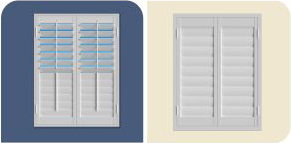
3 Ways Polywood Shutters Are Preferred Over Hollow Vinyl And Composite Shutters In Tampa, FL
December 15, 2015
The market for plantation shutters in Tampa is full of options. And when you are figuring out which non-wood shutter is best for you, it might be hard to discern the differences. You can unknowingly choose the wrong type and find yourself buying shutters that aren’t durable. Wondering if Polywood® shutters - our best-selling solid polymer shutters - are a better investment than hollow vinyl or MDF (multi-density fiberboard) shutters? Find out the three ways Polywood shutters are preferred over composite shutters in Tampa, FL so you can choose.
1. Polywood vs Composite Shutters Durability
Polywood shutters are made from high quality solid polymer that results in the most rigidity, color-retention, and durability than any other shutter on the market. This means the shutter louvers won’t warp over time. On the other hand, composite shutters are constructed from a pressed-board core, wrapped with poly-vinyl. The vinyl covering the pressed board is likely to peel off from the core material easily. And this peeling is accelerated in wet, hot, and humid environments. Hollow vinyl shutters are another option for non-wood shutters. But they disintegrate the fastest because of the elements.Both forms of non-wood shutters are likely to warp and deteriorate when exposed to the different environmental conditions in Tampa. Polywood is crafted with UV inhibitors that divert heat. And with heat being the biggest culprit in splitting the shutter louvers, Polywood is hands down the longest lasting plantation shutter for your home.
2. Polywood vs Composite Shutters Color Fastness
Polywood shutters come in three premium white paints. We bake the paint finishes on each element at temperatures hotter than it will ever get in Tampa, FL. The patented finishing process uses UV inhibitors to make sure the color will never fade.
Other types of non-wood shutters are available in no or low quality paint finish. In the majority of cases, the vinyl covering is the all the color you get. This finish may look good initially, but it fades over time. And as to hollow vinyls, some are painted. But since the material conducts heat, this seriously influences the finish over time.
3. Polywood vs Composite Shutters Energy Efficiency
Third party tests illustrate that Polywood shutters shield against 30° of temperature and result in a reduction of heat transfer by up to 45%. This means that Polywood insulates up to 70% better than a similar solid wood shutter.
Polywood’s insulating properties are a result of the solid polymer material. However what makes Polywood even more energy efficient than composite shutters is the weatherstripping on the louvers and panels. All you have to do is interlock the weatherstripping while closing the panels. This gives you an airtight seal against the impact of the weather outside. You won’t find all the energy savings that Polywood offers in any composite shutter.
The Sunburst Team In Vegas Puts The Durability Of Polywood Shutters To The Test
Back in 2004, Sunburst Shutters Las Vegas had Polywood shutters attached to the sides of their trucks as part of the graphics. They were parked outside and endured the climate Vegas is known for. That means excessive heat for five months out of the year!
Those Polywood shutters had been on our trucks for at least 7 years at that point. Our team organized a test to see how effective Polywood is in retaining the original paint color. The team wiped the Polywood shutter that was on the truck clean. And we held up a new Polywood shutter next it for comparison. We found the color to be unchanged. We didn’t see any discoloration or fading. This was further validation for the team that our paint finish is the best in the market!
And with Polywood withstanding that much heat damage on the road for more than 7 years, it’s hands-down the most durable shutter for your home in Tampa, FL.


